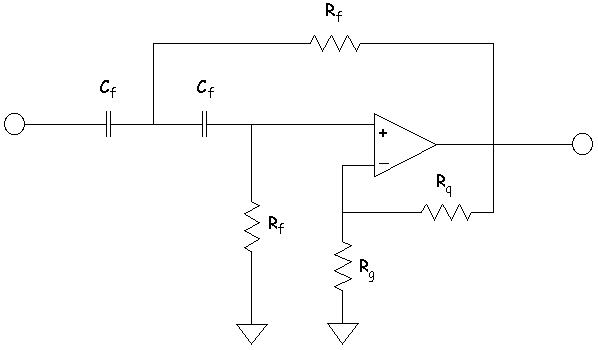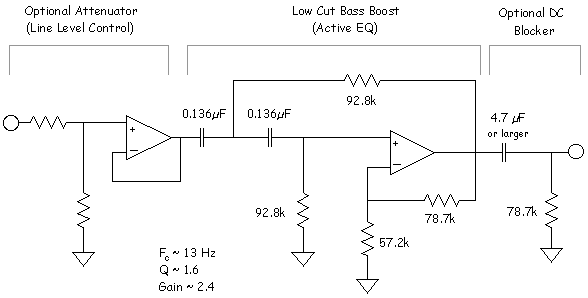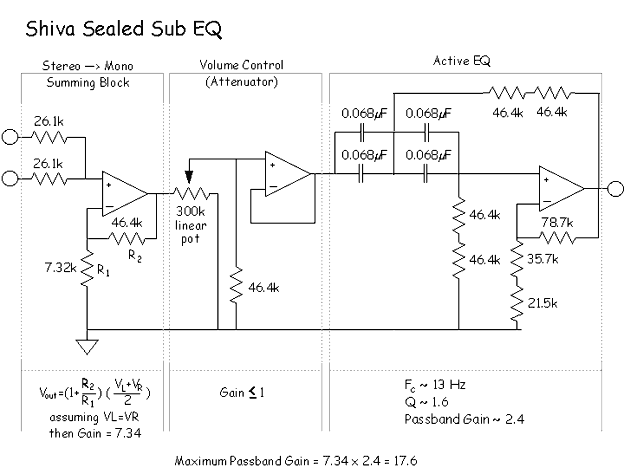
Active Crossover Kit for DIY SpeakerBuilders
Active EQ for Subs (Bass Boost)
Click Here to see details on the Subwoofer Only kit
The bass 'boost' is gained by using a highpass filter, with a verylow Fc, and a high Q. The most flexible ciruit for designing such filters isthe equal component Sallen Key Filter as shown below (see also Intro toActive Filter Theory):

Rf and Cf set the Fc of this filter. The RATIO of Rq and Rgsets both the over-all gain (volume level), AND the amount of Q (low-freq dB peak)at the same time. Adjust Rq and Rg to set the amount of boost (low-end dB lift)you want. For referance, a Q of 1.3 will give about a 3 dB lift, and a Q of2 will give about a 6dB lift. You probably don't want to go much higher than a Qof 4 for bass boost applications. Place this filter at the end of the filterchain, right before the output to your woofer amp.
For sealed sub design: Please download and use my modified BrianSteele spreadsheet (see top of home page) to calculate the 'optimal' boostparameters for you sub. If you own an existing sub, and don't know the parametersit was designed to, set your filter to a Q of 3.3 (Rg=9.53; Rq=16.2; other kit valuecombinations will also work), and set the Fc of your filter to slightly higher than* of your estimated woofer's resonant frequency.
For vented systems: You need to be more careful. Vented woofersbecome unloaded at frequencies below the vent tuning frequency (Fb). If you applyboost at a frequency much lower than the Fb of your sub, then your woofer will makebig excursions, and maybe die. Therefore, set the Fc of your boost filter to aboutthe same level as your Fb.
For those of you designing a sub from scratch for use with active EQ, then I'dsuggest that you use as EBS alignment when building your sub, and then apply a moderateamount of boost to the vent-tuned frequency. Try a Q of about 1.37 (Rg=5.76;Rq=7.32) for a mild +3dB boost at your Fb. The effects of the boost will also helpflatten the mid-bass output of your sub. Adjust the Q and Fc of the filter aroundfrom this starting point until you get a response that mates to your listening room(raise the Fc a little, and raise the Q up to 2 max). I'll bet you'll get pleasingresults pretty quickly. This seems to be an elegant way to extend your woofers response,as it will place a relatively small amount of boost at a relatively low freq, therebyminimizing the amount of noticable group delay introduced to the system. Furthermore,it will act as a highpass to protect your woofer from ultra-low freqs.
For existing vented subs, you may add a small amount of boost to the Fb of yoursub as it is, or better yet, lower the Fb of your box by lengthening the vent a little.You might try to retune your box to * of an octave lower, and then apply a Fc = Fb;Q=1.37 highpass to your sub's amp. Raise the filter Q or Fc as needed to achievethe flattest response for your room.
The Shiva White paper lists specific alignments that the folks at Avatar workedout for bass boost with vented (or PR) Shivas. I can provide the parts and schematicsfor these alignments with ease, since I know the optimal filter Q and Fc. Forexample, they discuss an active EQ 65L PR sub with an anechoic F3 of 22.4 Hz, andpower handling above 100 dB down at 18Hz. This is truly a fomidable sub,and an excellent option for those of you who want a ready-to-go soluntion for "life-threatening"sub performance.
A few other ciruits could be added to the above filter tomake it best suited for your specific needs. A few design examples are consideredbelow:
Shiva Active EQ
Initial Design: This gif was kindlyprovided to me by Dave Dlugos of the TransmissionLine Speakers page:

The above shows the initial schematic I cameup with for the sealed Shiva active EQ. Since then, I came up with an improvedversion (see below), but I'm leaving this schematic here for the purposes of discussion. I also have a version for the Shiva PR active EQ discussed in the White Paper. This is also very similar to the circuit above, with a few different values.
Since many people have fixed-gain sub amps, there needs to be a way tocontrol the volume of the sub. The first part of this circuit (a voltage divider)was included to reduce the level of the input signal. I felt that thiswould be desireable because the active EQ filter has a freq - independant gainthroughout the audio range, which I figured might make the sub sound too loud. Afterreconsidering the problem, I found that many subs (including the Shiva in certainapplications) might need to be fed voltage levels even higher than those producedby the added gain of the filter (see newer design below). Therefore, some ofyou may actually want added GAIN here instead of attenuation.
The second part is the second-order lowcut (highpass) dicussedin the Shiva White Paper docs. This circuit allows a 25.5 L sealed box to perform"essentially flat from 14 Hz to 70 Hz." This filter does this becauseit has a high Q, and therefore some freq - dependant gain centered around13 Hz to lift the low freq of your sub. See my Frequentlyasked technical questions (FAQ) page if you are confused about the differencebetween the freq dependant and independant gain.
The third part is a *very* optional DC blocker. Notethat the previous portion of the circuit has already cut the super-low freq's andDC out, so this last part is not really necessary. HOWEVER, your op amp willgenerate a small DC offset of it's own (about 1 mV). This very small offsetwill be amplified by your woofer amp (up to only about 30 mV, I'd guess) ONLY IFthat amp is DC coupled throughout. If you decide to use the DC blocker, youcan use a mylar or non-polarized electrolytic cap of 4.7 uF or (preferrably)larger. As I understand it, the dissipation factor of the electrolytic is OKfor passing low-freq signals such as these (mylar much better though). Wirea smaller mylar or polypro in parallel with the nonpolar electrolytic if you wantto be sure.
After reconsidering active filters in subwoofer applications,I designed a new circuit for this application:
General Subwoofer Considerations
Goal: Sub should integrate with satellites in passband and crossover regions.
Passband region of sub:
The nominal dB output of your sub(s) needs to match that of your satellites. Ifyou are using fixed-gain amplifiers, then there are a few important reasons you needto put gain between your preamp and your sub(s):
1) Woofer sensitivity is generally less than the satellites. Doubling the subamp input voltage level (gain) will raise the SPL of your sub by 3 dB. (Note thereare different ways of wiring the Shiva's voice coils, which will affect the driversensitivity).
2) Using only 1 sub instead of 2 cuts the effieciency of your sub in half relativeto your satellites (overall sub output 3 dB less). Therefore, double the gain again.
3) If you have an attenuator in your circuit to control the volume, you want toincrease the max gain further so that the mid setting of your attenuator is nearthe calculated desired dB output of your sub. Therefore increase the gain by at least4.
Using the above arguements, we see that 2 X 2 X 4 = 16. Therefore you should setthe gain of your circuit around 16, and use the attenuator to decrease the volumedown to the desired level which mates with your satellites. This is a general ballparkgain estimate which will work for most subwoofers. The attenuator will clean up theslop. After considering these issues, I came up with a new 'Mono Shiva acitveEQ circuit,' which was also drawn for me by Dave Dlugos:
New Design:

This circuit is comprised of a summing block with gain, avariable attenuator (volume control), and the sealed Shiva EQ filter. The two26.1 k R's mix your stereo signal down to mono. R1 and R2 control the gainof this section. The entire circuit has a max gain of 17.6. Change R1or R2 to alter the max gain of the circuit for your sub if find that you really needto (increase R1 to decrease the gain). The attenuator is used to bring thelevels down to your listening preferences. Depending on your application, theleft and right inputs are connected to the preamp out, or the output of your bufferop amp, or the output of your highcut (lowpass) sub filter. You will probablywant to rearrange this circuit depending on your needs:
1) You have an integrated amp driving the sub: In thiscase, you don't need any gain or attenuation stages. The volume control onyour amp will do these functions.
2) You are using stereo subs: In this case, you must omitthe summing function, but you'll still need gain and attenuation stagesif you have a fixed-gain amp. You could put the gain R's on the volume controlop amp, and omit the first op amp entirely.
3) You are using a mono sub with an active highcut filter: Inthis case, it makes most sense to put your mono summing block BEFORE the active highcut. That way, you need only build a MONO active sub highcut, and you'll save extraop amps and caps. Here's the flow of the functions: pre amp - activecrossover input buffers - mono summing block with gain - mono sub highcutfilter - volume control - active EQ filter - output to sub amp.